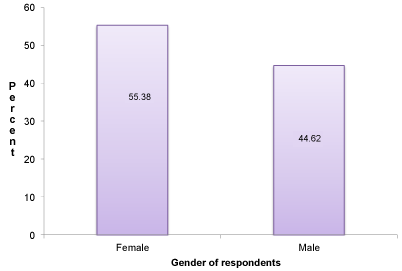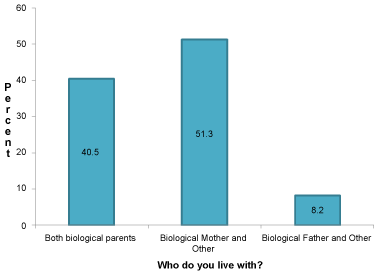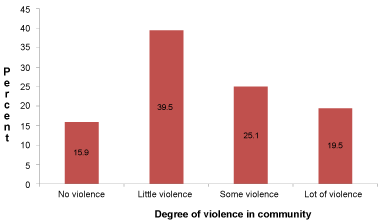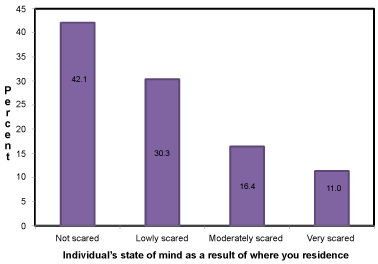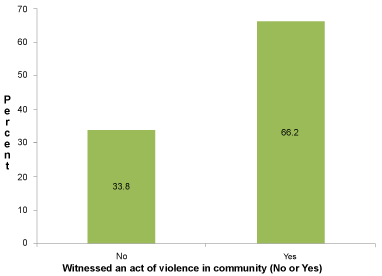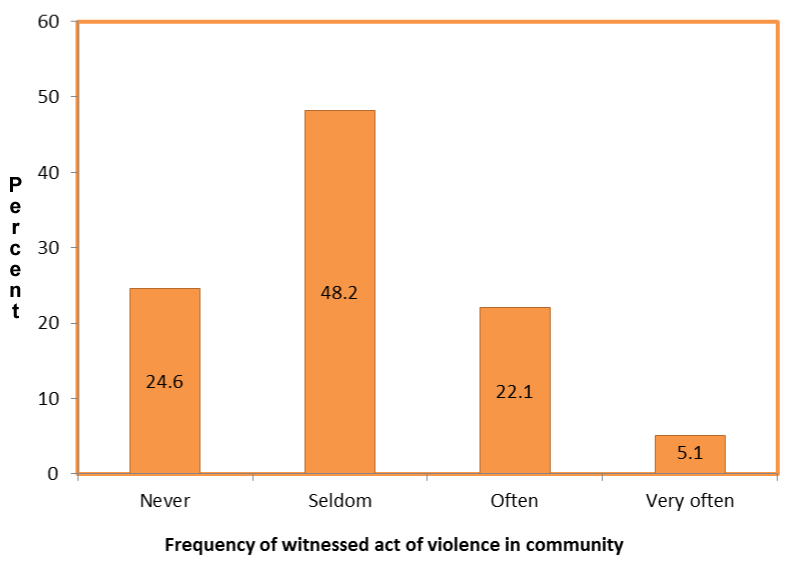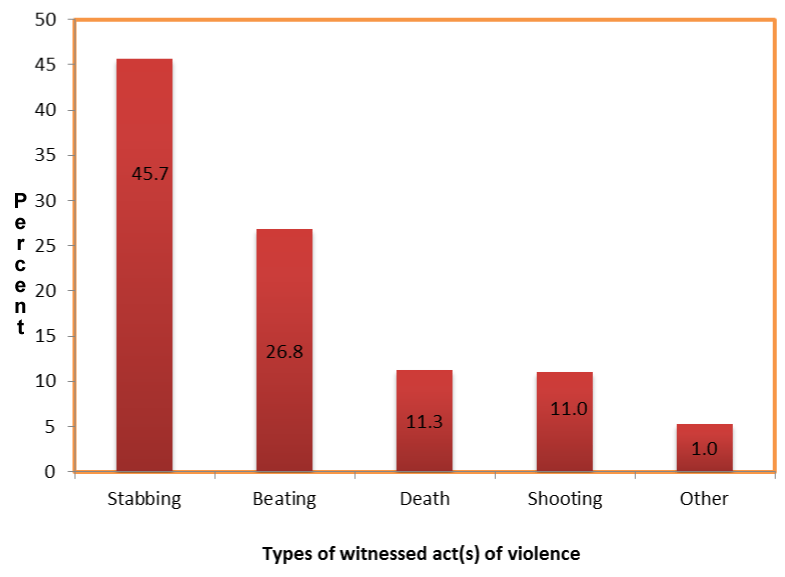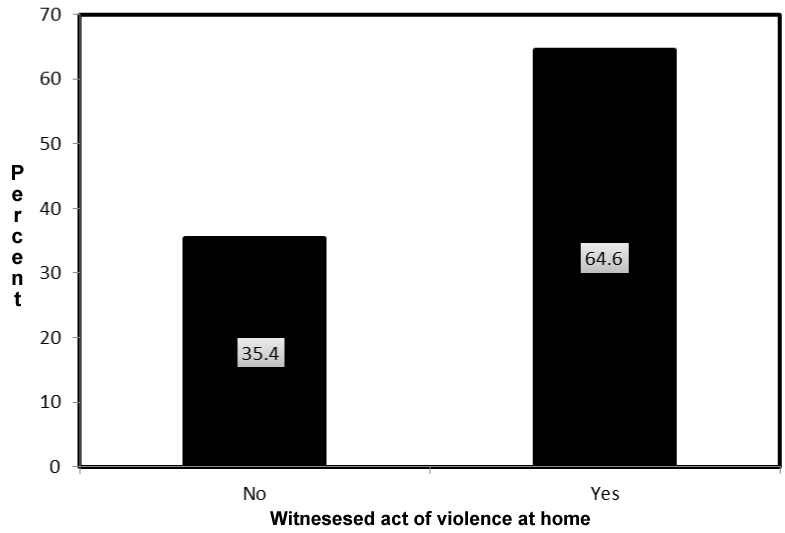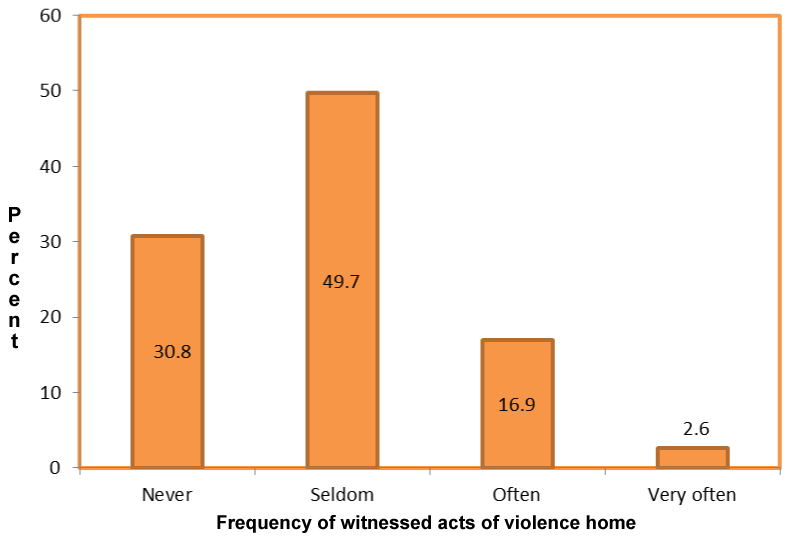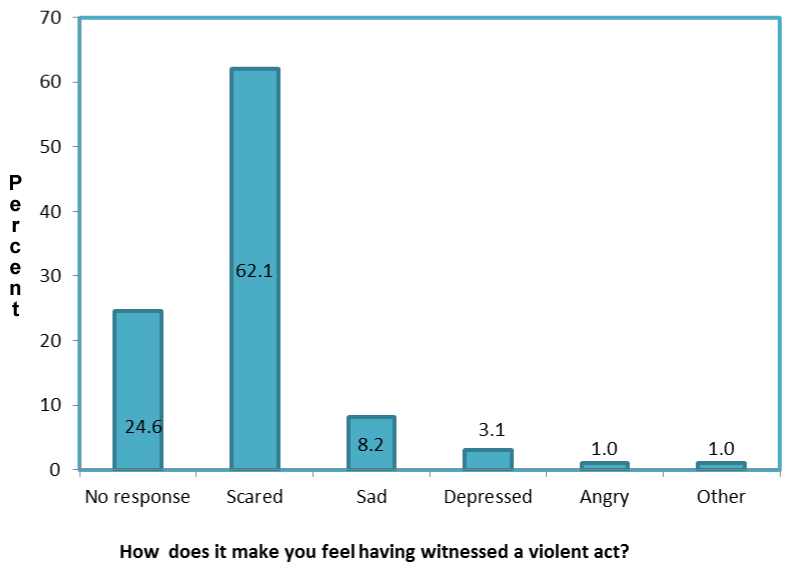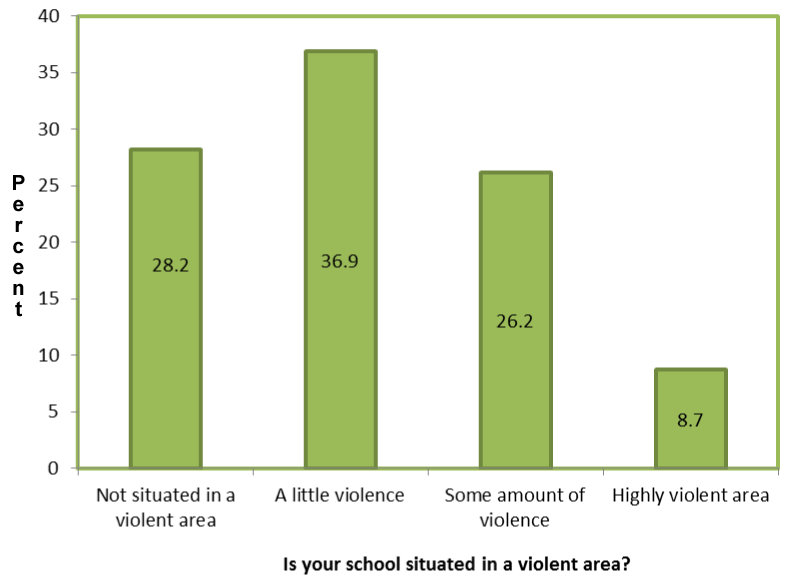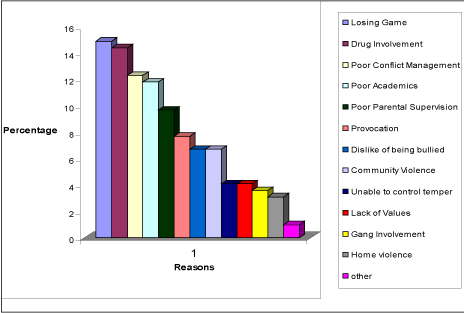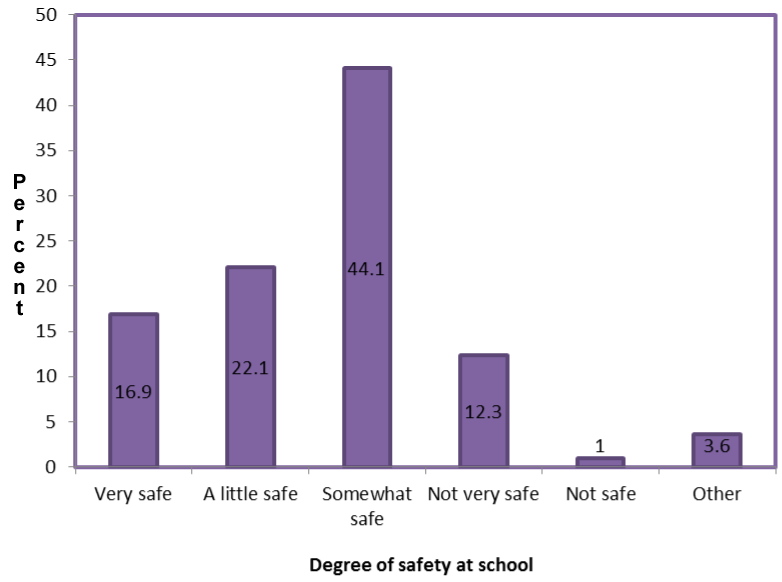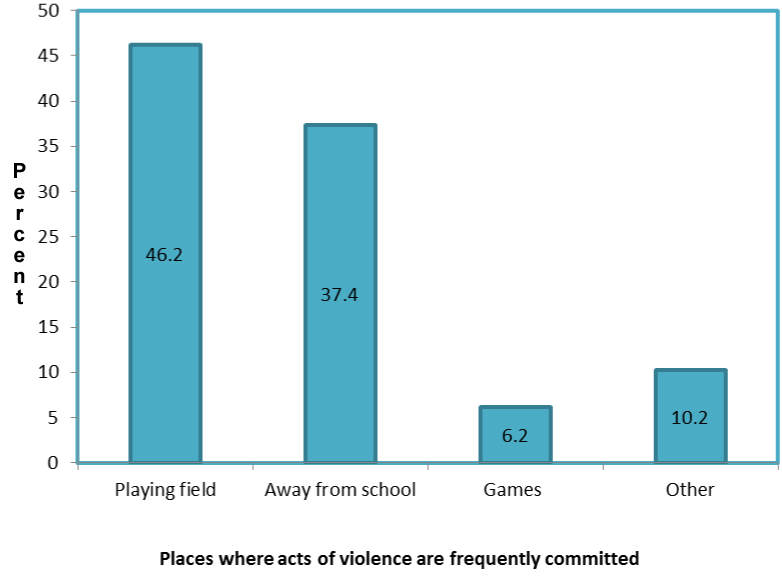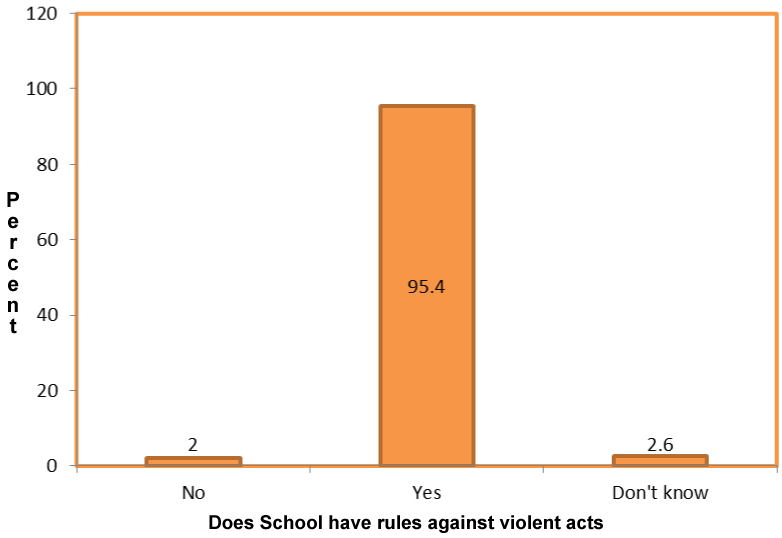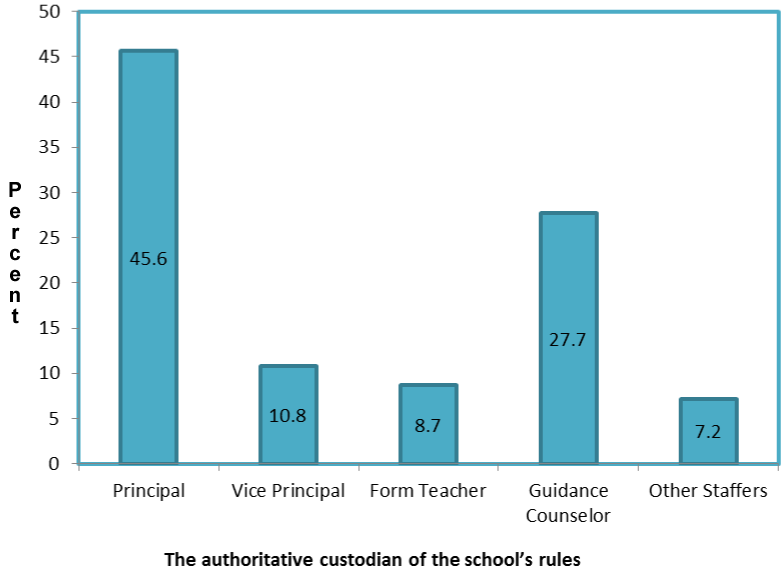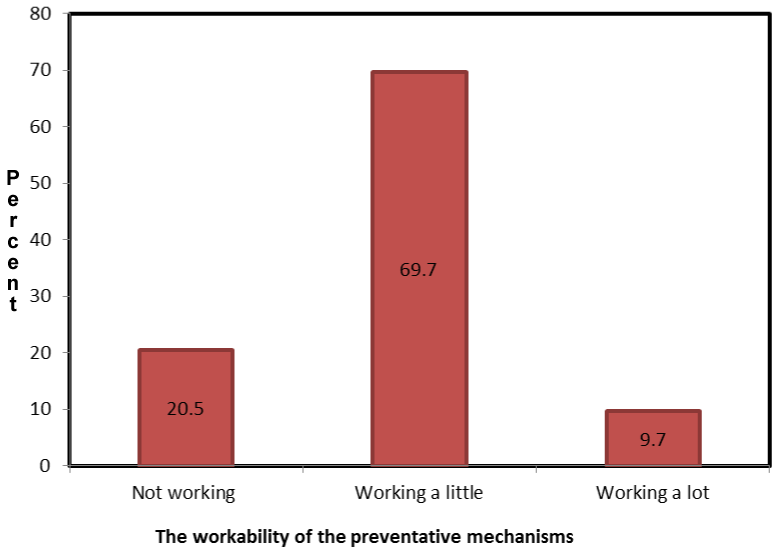Students' Perception of Curbing Deviant Behaviours in Jamaican Secondary Schools: An Assessment of the Corrective Measures Used in Behaviour Modifications by School Personnel
Abstract
Objective
Social deviance continues to be a challenge in our world, including Caribbean societies. Some people feel that such behaviours should be tackled by corporal punishment, and this is primarily a product that is taken from their socialization. But, there is an issue that we still have not resolved which is rooted in the questions; does violence begets violence? and what are the dynamics of employing those measures in our educational institutions? Within the Jamaican educational space, school personnel in some secondary schools continue this ancient belief that the way to address deviant behaviours is still through corporal punishment. They perceive that acts of violence can primarily be ameliorated by negative reinforcement, i.e., flogging, expulsion, detention and suspension, in which minimal efforts are placed on counseling. This research provides an insightful analysis of corrective mechanisms used by school personnel and the students' perspective on their effectiveness in addressing acts of violence. It also equally serves as a catalyst for a significant drive to use counseling, as it is one of the approaches in behaviour modification without the scar of more violence.
Method
This paper seeks to use a quantitative case study-survey approach. The research design also utilizes a cross-sectional study, which explores the mechanism of correctional interventions used by school personnel and their effectiveness in reducing violent acts in schools. It is a convenient sample of 195 10th and 11th graders taken from two inner-city secondary schools within the Kingston Metropolitan Region. Both schools were selected because they are known to rely heavily on corporal punishment as means of behaviour control. Both schools also represent cases of schools with large numbers of students that have experienced some degree of community violence.
Results
Some 81% of the students reside in communities that are experiencing some degree of violence with 66.2% of sampled population having witnessed some act of violence, and 11.3% having witnessed murders. These figures point to the social nature of the problem of violence in schools. The social dynamics of the external environment in which these students reside, cannot be divorced from any analysis of the problem or solution. The high levels of internecine violence that characterize some communities where some of these students are from, will have an effect on the behaviour of these students in school. The organic nature of our modern society means that, behaviour in one part of society will affect behaviour in other sections of the society. The findings also revealed that 64.6% of the respondents said that violence was also a regular occurrence while at home; with the same percentage of students saying that the traditional methods used in an effort to curb deviance 'needs to be readdressed'. The students believe that the most effective medium in addressing acts of violence in school is counseling and not the 'zero tolerance' approach, which is traditionally used.
Conclusion
Flogging was found to be a marginal deterrent in alleviating acts of violence at school and equally so was suspension. Expulsion, on the other hand, was highly effective in addressing issues relating to 'shooting' whereas counseling was most effective in addressing issue relating to threats, stealing, physical confrontation and 'stabbing'. Nevertheless, less than one-quarter of the respondents' reported that corporal punishment is not working compared to more than two-thirds who said that this is working, but just "a little". It follows, therefore, that corporal punishment is an ineffective corrective mechanism in addressing social deviance in the cases studied.
Keywords
Corrective measures, Corporal punishment, Social deviance, School management, Violence in schools
Introduction
One of the challenges that face many Jamaicans is how to discipline their progeny, as in the past some guardians and/or parents have abused them. This occurs because of the extent of the methods used in the disciplinary process. This is based on the fact that the Jamaican culture epitomizes corporal punishment as a medium of corrective behavioural modification. Thus, we are tossed into a culture that sees corporal punishment as a vital deterrent to social deviance. This is more so evident at the primary level of our school system, but is still a feature within some secondary institutions. There is a saying in Jamaica, "Don't spare the rod and spoil the child", which speaks to the need for corporal punishment as a measure of behaviour modification. Secondary schools are somewhat different, in that, corrective measures have moved beyond flogging to (i) Standing in the sun, (ii) Detention, (iii) Suspension, and (iv) Expulsion. What stands out as a result of the implementation of these measures is that these procedures did not perturb those who were frequent mischief-makers. By the end of high school, we had seen all the measure used on our classmates, and ironically the mischief-makers continue their practices even long after graduation.
Schools are microcosm milieu of the community, so students are socialized to expect corporal punishment as negative reinforcement for some social deviance. This does not deter them from carrying out their activities. Indicators of the extent of social deviance currently expressed by our students are identified in the following cases: When students of Jamaica College were engaged in 'war' with students from Mona High that is in close proximity; when it was alleged that girls were having sex in buses; and when a group of students (including girls) were caught on camera pouncing on a security guard, who allegedly shot a student, and trashed sections of the school. Many of the students involved in the aforementioned acts are cognizant of corporal punishment, detention, suspension and expulsion, but these did not deter them from continuing their actions.
Contextualizing the Study
One of the rationales that exist for this study is the increased acts of violence which have become apparent within a vast number of Jamaican secondary educational institutions [1]. Besides causing physical harm, there is the socio-psychological distress associated with violence. In order for students to grasp the necessary knowledge, skills, and competencies that are offered by our school system, it is important that the school's environment be free from fear, victimization, and violence and experience a certain desired level of safety [2]. This is only achievable if the worrying trends of violence were reduced and/or eradicated. Teachers and students alike should be able to perform in a safe setting that is conducive to learning. The problem is an ongoing one, therefore this study will concentrate on an evaluation of the effects and the methods used to prevent violence among 10th and 11th graders of two Corporate Area High schools. This study will be able to shed light on the mechanisms used by schools to curb violent behaviour and their effectiveness (or ineffectiveness), and also will help to create awareness for school administrators and stakeholders of the various strategies, and those that are workable.
Schools have been portrayed as unsafe places, characterized by rapes, shootings, stabbings, and beatings. The occurrence of acts of violence in the form of verbal threats, cursing, name-calling or fights is more frequent [3]. The main author has taught within Jamaica's secondary level educational institutions for approximately fifteen years - working in preparatory, junior high, traditional, technical and comprehensive high school, the issue of violence within these institutions was different. Over his entire career, incidences have ranged from stabbings, physical conflicts, a few students took their guns to schools, but he has never witnessed a student shooting or murdering another colleague. In this regard, this is not substantiating enough for him to justify Bastian and Taylor's claim. However, it appears that some schools within particular topographies are more likely to experience more acts of violence than others. In inner city communities, violence seems to be a part of the landscape of the environment and this is equally manifested in the schools in these areas. Thus, the milieu of the community does influence the children during their school years.
Grumpel and Meadan [4] stated that, although there is widespread violence in schools and it has been receiving much attention, there is still a lack of clarity as to what constitutes school-based violence. This, some believe, may influence the reporting of prevalence rates. Batsche and Knoff [5] stated that school violence is usually defined by acts of assault, theft, and vandalism or acts that may not be intentional but cause fear in either teacher or student. Gumpel and Meadan further classified aggressive behaviors as either acts that are clearly violent as in the case of those inflicting bodily harm or lower level type consisting of those including teasing, bullying or name-calling.
For the purpose of this research, violence is defined as behaviour involving physical force intended to hurt, damage, or kill [6].
Although it is proving difficult to control the violence in schools, there is still the expectation that some form of order be maintained. This is of particular importance as besides being a threat to the personal safety of students and teachers, violence in schools is a challenge to the authority of school officials. When violence occurs on a school compound, it is viewed as an evident loss of authority [7].
Devine [8] stated that teachers adopting a 'hands off' response to violence and concentrating only on their role in the classroom have led to the escalation of violence. The easy access to news and information through the Internet and other electronic media regarding the use of weapons is cause for concern as students adopt several types of deviant behaviours portrayed on stage and act them out in school. Students are exposed to violence in the media, which can result in acceptance and emulation of aggression. Centerwall, Ascher, Widom [9-11] believed that exposure to violence causes one to commit acts of violence. Felner and Felner [12] stated that family variables, individual characteristics, and societal factors affect violence. Family variables include economic status, divorce, abuse as well as unskilled parenting. Individual characteristics include antisocial behaviour, psychological disorder, and personality. Societal factors include access to weapons, media violence, community violence or influence, as well as inequitable educational opportunities. The contributors to violence among adolescence have been attributed to several factors. These include conditions in the home such as harsh and ineffective parental discipline [2] and frustration caused by students' inability to resolve conflict [13,14]. The influence of the community [8] is a causal factor of violence by the adherence to norms and values of the society.
Norguera [7] stated that teachers' and administrators' unfamiliar with the environment from which students come, contributed to unfounded stereotyping of students. This affects a positive interaction between students and teachers. To Norguera, the use of security guards, metal detectors, and fenced and grilled buildings seldom reduce the threat of violence. The violence in school cannot be eliminated totally; it can be lessened if there are improved interpersonal relationships both within and outside the school community. The measures for prevention will yield varied results in different situations but this study will undertake to find out interventions which are most effective.
Various studies have been conducted on violence in schools-its causes, effects, and measures for prevention. We, as researchers, are not aware, however, of studies being conducted to evaluate the success of the preventative measures employed. This study, therefore, will endeavour to include an evaluation of the measures implemented for the prevention of school violence. It should be of particular importance to school administrators, the Ministry of Education, and other interested stakeholders. It should provide them with information which, it is hoped, would assist in future plans and actions towards making the school a safe place.
The current study is timely as it examines corrective measured used in secondary schools in Jamaica as a medium of classroom management, and whether these are effective corrective strategies from the vantage point of the students. This paper offers the students' perspective on the degree of effectiveness of corporal punishment employed by personnel in secondary school as well as their views on appropriateness of other measures that they believe are more effective in addressing social deviances in school.
Literature Review: Conceptual Framework
The phenomenon of social deviance has been extensively studied, particularly among school children. This section of the paper will critically review some scholarly works on the matter in an effort to contextualize the current research as well as provide a platform for theoretical underpinning that will be used to interpret this work. Among the issues that will be explored are the matter of corporal punishment and alternatives to alleviate or reduce the deviant behaviour in schools.
Risk factors that contribute to students' involvement in violence
Risk factors relate to those characteristics of the person or the environment that are associated with an increased chance of maladaptive behaviour occurring [15-17]. The contributors to violence in schools are viewed as a reflection of what takes place in the communities, the home, the media, and the school environment. It should not be surprising then, that an increasing number of students are involved in violence in one way or another as victims or perpetrators. Social learning theory posits that people acquire aggressive behaviours through observing and imitating [18]. This shows that violence is a learnt behavior. Hawkins and Catalano [19] have identified several risk factors in young people that are predictors of later violence and antisocial behaviour. Among these factors were stress, and alienation, both linked to a lack of bonding to school, family, and community. They believed that learning pro-social skills not only helped young people with their interpersonal relationships, but with their attitudes towards school as well. Such improvement would yield higher academic achievement and a more cooperative school climate. This would help to erase the students' negative and antisocial behaviour. They stated that it was important not only to see the skills modeled, but that they are practiced in a setting where feedback and reinforcement were provided for the choice of skills. In Jamaica, there has been attempt by programmes such as Peace and Love in Schools (PALS) and Change from within which teach skills about how to deal peacefully with conflicts. An article by Prevention Institute [20] concluded that the frequency of an individual's exposure to risk factors predisposes him or her to the probability for increased engagement in violent behaviour. These were listed as individual factors, school factors, and community factors.
Individual factors included poor academic performance, poor use of unstructured free time as well as delinquent peers. School factors had to do with the size of the school population, geographic location, and gangs. The larger the school population the more likely it was for occurrence of violent acts. Schools situated in urban areas were more prone to report serious violent acts compared to those in more areas that are rural. In communities, a lack of inadequate social amenities brought about a feeling of societal neglect by students. Their anger and frustration were vented by violence. Turner [21], in analyzing Ralf Dahrendorf's work on 'Conflict in Society' as an aspect to its functionality, forwarded the position that particular deficiencies within society explains some of the violence that are evident in society.
According to Turner [21], Dahrendorf saw the manifestation of conflict, through the formation of organized gangs, as the result of technical (leadership and unifying ideology of the structure), political (capacity to organize), or social (ability to communicate) conditions of the organizations. He (Dahrendorf) believed that gangs (or organized groups) are in direct relation to the problems of the structure, and the intensity of violence is directly associated with perceived difficulties of the people to operate because they perceive the system to be unjust to their concerns. He noted that the 'less technical conditions' are presented to the subordinate people, and the less social conditions are met, the more intense are going to be the conflicts [21]. Thus, embedded in Dahrendorf's theorizing is the link between society role in the creation of gangs, and violence, because of mere neglect of the less fortunate.
Although Dahrendorf did not speak to the problems in schools, his theorizing is fitting to these problems. As the political, social, and technical conditions within some schools are interpreted by their pupils as oppressive, along with the inadequacies of a proper learning environment which 'mimics' the deficiencies with many inner city areas, this will fuel conflicts among the various subgroups (including the schools' personnel) in these organization. Thus, the teachers' role must be to narrow these divides between themselves and the students in an effort to reduce any tensions that may be brewing in the students, derived from their homes and the wider communities from which they come. This therefore explains why, when the technical, social, and political conditions are not viewed by the pupils as fair, the likeliness that these will create conflict even without negative reprimand (such as flogging, detention or even exclusion). Some of the students reside in violent communities, and so open flogging may not be seen as reprimand but as a symbol of 'disrespect'. Therefore, the student in keeping with the wider community's symbol of self and respect may resort to further deviant acts. This is so, as dissent and conflict are in keeping with the wider society's (inner city areas) expectations of them, because this is interpreted as strength of self in the game of these areas.
Coser (1966, 1967) [22,23] helps to explain how violence and conflict are social ailments, and that they should not be construed as mere deviant acts. He likened violence to 'pain in the human body' that informs the individual that there is danger, and not that social pressure should be administered to this situation. Hence, Coser argued that "dissent may more readily be explained to what is perceived as a sickness in the body social" [24]. This dysfunction should be carefully understood, as negative reprimand (in the form of flogging) could be fueling the dissent. Thereby, this could result in intense conflict between pupils and teachers, pupils and pupils, or among teacher-pupils and the community. From such a situation, without an understanding of this symptom of social deviance, it could exculpate into conflicts that may lead to disruption and malintegration of the social structures-that is the school, pupils, and the wider community. Flogging, therefore, could be a precursor to conflicts as it reduces the legitimacy of the school's personnel in the eyes of pupils. But there are other institutions that equally play a significant role in students understanding of what is expected in the social system.
The media has portrayed violent behaviour as a way to solve problems [25,26]. Young people therefore became desensitized to and accepted violence as a means of settling disputes. The prolific use of guns on screen was yet another factor leading to an increase in violence in schools. Easy access to weapons increased their use in society. Like most other views expressed, students were most likely to be violent if they were witnesses of violence or were subject to childhood abuse. Students came to see the world as a dangerous place. To survive one had to be prepared to react to adverse situations which were always present. Such an attitude promoted a sense of defensiveness, suspicion, the need for standing one's ground, and inclination to offer reprisal for the slightest offence.
Other underlying factors were poor financial situation, stressful family environment with lack of proper role models, conflict in the home, and poor communication skills. Mental illnesses and mental disorders impaired students' ability to communicate and make right decisions. They were therefore at an increased risk of being perpetrators or victims of violence. Fernald and Meeks-Gardner [27] cited that in Jamaica, although students are exposed to violence, those in the inner cities are exposed to greater levels of crime and violence. These students prove to be more aggressive and resort to violence to settle their problems.
Leone, et al. [28] noted that hyperactivity, limited attention span, restlessness, and poor social skills favor the development of delinquent behaviour. The beliefs and attitudes of some students dictated that there should be retaliation for any and every situation. In addition, students with certain disabilities, for example emotional disturbances, Attention Deficit Hyperactivity Disorder, and specific learning disabilities were more likely to display antisocial behaviours.
Conditions in the home provided early onset of chronic patterns of antisocial behaviour. These were linked to harsh and ineffective parental discipline, lack of parental involvement, family conflict, parental criminality, child abuse, or neglect [2]. Lacey and Miller [29,30] noted that Jamaica like the wider Caribbean is primarily a matriarchal society.
The absence of fathers in many households negates positive parental values. The increasing number of teenaged mothers heightens the problem of children being given proper parental guidance.
Kleck [31] believed that students were increasingly coming from backgrounds where antisocial behaviour was more the norm than the exception. The students were highly agitated and invested in antisocial attitudes and beliefs which made the use of antisocial solutions to interpersonal conflicts legitimate. They tend to see the behaviour and intentions of others as being biased against them. This bias helped to distort the ability to decode and interpret the social behaviour of others in a positive way. They frequently react aggressively to situations they view as challenging or threatening.
Shafii and Shafii [32] stated that children learnt to resolve their own problems through the use of violent strategies which they see being used. They imitate the behaviour of others and receive positive reinforcement from their peers when they deal with interpersonal conflict in a positive manner. Based on the background many children experience, some of them will resort to violence when they have exceeded their tolerance of frustration levels. Hill (ud), et al. [33] posit that many of the young people report a history of violence in their lives. It is further reported that at some time in their lives, they thought about hurting or killing someone. This reinforces the fact that when violence is experienced, whether as victim or perpetrator, there is the increased risk that an adolescent will resort to violence against others.
Skiba and Peterson [14] showed that influences in the school and community helped to establish patterns of aggressive and violent behavior. Low school involvement, academic, and social failure were some of the school factors named. There was failure to carry through rules as well as poor or inconsistent administrative support. In addition, disciplinary practices in many schools were inconsistent and inequitable. Students from communities in which there was a lack of programmes, whether recreational or after school, were prone to adopt violent behaviours. The absence of mentors helped to foster an adherence to antisocial behaviours. A lack of emotional or financial support may be gained through involvement in antisocial behavior.
Steinberg [34] examined the role of the family as a contributor to violent behavior in children. He stated that exposure to violence or abuse in the home, exposure to hostile punitive parenting, or growing up in a home environment in which parents were not sufficiently involved in the child's life were among the most important risk factors for the child's subsequent involvement in violent and other types of antisocial behaviour. He looked at the role of the family from six perspectives: Modeling, biological factors, mental health, parenting, personality development, academic performance, and peer pressure.
Biological factors relate to early abuse and neglect. He pointed out that poor prenatal care, or prenatal exposure to drugs could alter brain development. This led to some children having more difficulty containing aggressive impulses. Children whose parents were hostile and punitive as well as those whose parents were neglectful were at risk for developing all sorts of mental health problems. Children with mental health problems were at risk for developing patterns of antisocial and violent behaviours.
Steinberg [34] also showed that adolescents who had the greatest number of problems with antisocial behaviour, personality development, and in general mental health, came from families in which parents were hostile, aloof and uninvolved, or detached in the child's life. Many parents have abandoned their role and children are either left on their own or with relatives. Often these children do not learn positive values and resort to anti-social or delinquent behaviour.
Parental aggression, hostility, and disengagement were good precursors of many problem behaviours. Children were more likely to show psychological problems both in terms of misconduct and types of distress. They proved to be less interested and successful in schools. The television and other media were frequently blamed for today's epidemic of violence. The absence of fear, grief, remorse and consequences for violence on television, in movies or music, sends a wrong message. They showed that violence was an acceptable way to solve problems as well as a symbol of power. The brutality depicted was unhealthy and even dangerous. Donnerstein, Slaby, and Eron [35] stated that persons who viewed a lot of violence on television began to see the world as a mean and scary place where aggressive acts were acceptable means of solving problems.
Pepler and Slaby [36] maintained that violent students think differently from their non-aggressive peers. Youths who were prone to violence sought fewer facts and had less insight into alternative solutions. They often failed to anticipate the negative consequences of their behaviour. Violence in schools has several negative effects on students. Some of these are addressed in the next section of this study. These students believe that if they are approached with violence, they have to react violently; otherwise they will be called derogatory names.
Impact of violence in schools
From the literature reviewed, violence in schools has varied and far reaching effects on students, teachers, and the school system. The incidents of violence in schools not only posed a threat to the safety of students and teachers, but also proved to be a challenge to the authority of school administrators [37]. Many teachers have been verbally abused, physically attacked or threatened by students or their relatives [38,39]. If schools are to be safe there should be a lack of psychological stress and physical harm [40]. The antisocial behaviour of students endangered the safety of school personnel [41,42]. Students and staff members suffered psychologically and physically because of violence in schools. Some incidents have been fatal.
It is believed that students feel powerless when attacked or provoked hence, they resort to violence in order to regain a sense of power [43]. This was evident in a series of school related shootings which took place in the United States [44,45]. Incidents of shootings in Jamaican schools are few but there have been frequent stabbings, some of which are fatal.
A report published by the National Association of State Board of Education of Virginia in 1994 outlined some of the effects of school violence on teachers, students, and the learning environment. The report recorded examples of the negative, physical, social, emotional, cognitive, and psychological effects.
Students who were victims of violence may exhibit feelings of fear, anger, sadness, guilt, and mistrust. Violent or disruptive behaviour could destroy a positive learning environment. The fear that was generated by the acts of violence inhibited the ability of teachers to teach and students to learn. Cognitively the students, who were fearful, may have trouble paying attention, concentrating, and learning. In order to ensure the safety of children, parents might keep children from school, thus affecting school attendance. Some may even be permanently removed. From a social point of view, students who had either witnessed violence or been a victim, may be either disruptive or aggressive and have difficulty relating to other students. Psychologically, behavioural disorders may occur. Schools suffer from a lack of extracurricular activities as a response to campuses being unsafe. Violence in schools therefore interferes with optimal learning as an atmosphere of fear is established.
Bullying which frequently occurred in schools was often taken lightly but could have serious effects. Students who were bullied may suffer from depression, low self-esteem, or anxiety. The fact that students may feel unsafe at school significantly interfered with learning.
Schneider, et al. [46], Salmivalli [47] and Woods & Wolke [48] outlined the effects of bullying which he defined as purposefully doing harm to others. This was facilitated through ever repeating physical assaults, verbal and physical intimidation, harassment, and constant molestation. The damage to the victim was of a mental nature rather than physical. The humiliation lasted for years, with the victims suffering from reduced self-esteem. This could affect academic and social outcomes. Rigby [49] showed that students who had been harassed by peers had suffered depression and experienced suicidal ideation. Olweus [50] reported that students subjected to frequent bullying often sought refuge from teachers during breaks, avoided restrooms and other isolated areas, or made excuses to be absent from school. They appeared distressed, unhappy, and depressed with evidence of deterioration in interest and performance in school.
Biovin, Hymel and Hodges [51] showed that there was a relationship between peer harassment and academic performance. Victims tend to develop negative attitude towards school and overtime school performance declined.
Dodge, Bates and Pettit [52] concluded from studies done showed that abused children tend to acquire deviant patterns of processing social information. This fostered the development of aggressive behaviours. Harmed children had a bias to attribute hostile intentions to others and a lack of positive behavioural strategies to solve interpersonal problems. These patterns were found to predict the development of aggressive behaviours. The experience of physical harm influences a child to conceptualize the world in deviant ways that later perpetuated the cycle of violence. The viewing of television violence overtime helps to reinforce hostile thoughts which the viewer might have had [53]. The viewer always seems to be able to recall the violent scenes in a graphic manner.
Osofsky [54] reported that exposure to violence could have significant effects on children during older development, and as they form their own intimate relationships in childhood and adulthood. Although literature was produced on the various developmental stages, the literature relating to adolescents was found to be most relevant to this study. She posited that evidence from research revealed that adolescents exposed to violence, particularly those exposed to chronic community violence throughout their lives, tended to show high levels of aggression and acting out accompanied by anxiety, behavioural problems, truancy, school problems, and revenge seeking. Children exposed to family violence often displayed internalizing and externalizing behavioural problems in comparison to children from non-violent families. Internalizing behaviours included withdrawal and anxiety while aggressiveness and delinquency manifested externalizing behaviours. Overall functioning, attitude, social competence, and school performances were often affected negatively. Longitudinal studies, according to the writer, had revealed that children exposed to media violence, overtime were most likely to engage in delinquent and aggressive behaviour. Media violence may increase negative behaviour because of the potential for social learning and modeling of inappropriate behaviour. Fictionalized violence that was dramatically portrayed and glamorized was likely to have negative impact on children and increased their propensity for violence. Television programmes and movies show graphic acts of violence as well as provide violent role models with whom adolescents can [55-64]. By observing models in violent and aggressive behaviors, the children react in a similar way. Many of the themes portray jealousy, revenge, and violence [43].
The long term viewing of television violence does have a negative effect on students as with a preference for "action movies" they can be seen acting out what is viewed. It should be noted however that if properly utilized and if guidance is given during viewing the television can be used for educational purposes. Hawkins and Catalano [19] addressed the aspect of resiliency. They defined resilient persons as those who were exposed to potentially damaging environments, events, or circumstances during the course of their development. They were either able to resist them or overcome the effects of the high risk conditions. They have been identified as possessing, among other qualities, strong social competence and problem solving skills. This demonstrates why some students, although faced with risk factors which promoted violence, do not become violent or aggressive.
Christle, Joviette and Nelson [65] looked at certain protective factors which account for one to be exposed to risk factors but do not display aggressive and violent behaviour. Like risk factors, protective factors may be strengthened through interaction with other factors. These include individual, family, school, and community factors. Individual factors include having a more positive view of one's life circumstances and stress reducing strategies. Family protective factors are viewed against the background that there is an attachment to at least one family member. This member not only provides a sense of belonging, but shows the child that he or she is valued. In the schools, both teachers and administrators can assist by providing a positive and safe learning environment. There should be the setting of high yet achievable academic and social expectation which should be facilitated. Students should be encouraged to be members of positive groups in the school, as this would help to deter demonstration of aggression or violence. The social structure in the communities could help to prevent students from engaging in antisocial and violent behaviour.
Strategies to decrease incidents of violence
In order to decrease the threat posed by violence in the schools, many strategies have been utilized. They range from, punitive to the more humane ones, which include counseling and the teaching of conflict resolution skills. Skiba and Peterson [66] outlined the many strategies which were being implemented to help with the prevention or decline of antisocial or violent behaviour. These included the use of metal detectors, security guards, dress codes, zero-tolerance policies resulting in suspension or expulsion for certain types of aggression or threatening behaviour. Strategies for identifying students most likely to commit violent acts were formulated. The use of strong disciplinary tactics in response to disruptive behaviour were maintained.
Mulvey and Cauffman [67] stated that despite the violence which occurred in schools, these institutions had proven to be one of the safest places for youths. The fact that violence does occur in schools had led administrators to devise various strategies to stem the incidents of violence. Some of these strategies, they believed did more harm than good to the students. Their focus was on the strategy aimed at identifying and intervening proactively with potentially violent students. This they thought posed several challenges. The nature of the problem may have social underpinnings and to focus solely on the individual would not achieve the desired result. Adolescents, they stated, were still undergoing developmental changes hence their characteristics were not fully formed. They reported that although it was not clear which intervention worked, the ones which focused on building specific skills were more likely to work. There should be on-going evaluation of the factors which increased or decreased the likelihood of one being violent. Students should be encouraged to give information on students who were facing problems or prone to violence. This could only be achieved however, if there was a supportive and healthy school relationship which would foster a sense of belonging and decrease any feeling of alienation. Students would then feel freer to give information. On the contrary students felt mistrusted and uninvolved when administration adopted a zero-tolerance approach or resort to corporal punishment.
Lantieri and Patti [68] described a programme which recognized that the ability to manage emotions, resolve conflicts, and alleviate biases, were fundamental skills to be taught. Schools which were viewed as being able to perform a socializing function in students were able not only to nurture their thinking abilities but to practice handling their emotions learn how to deal with conflicts and gain exposure to societal values. To achieve this however, the skills for improving emotional competence should be taught.
Norguera [7] stated that the search for solution has generated many strategies. Some of these were coercive and harsh, while others were more humane. There had been a preference however for the harsher ones in an effort to maintain authority, power, and control. Some of the more popular measures include the enactment of zero tolerance policies which serves to remove students who are involved in violent acts. The methods used are through suspensions, or transfers. Besides the use of these strategies, violent act or even nonviolent ones are treated as criminal offences. Despite the drastic approach being taken schools were still unsafe. The use of coercive methods interrupted learning and produced an environment of mistrust and resistance. Some schools had undertaken less coercive measures such as mentoring and the teaching of conflict resolution skills. The introductions of conflict resolution programmes were instituted to teach students to settle their disputes in a non-violent manner. Through the use of adults as role models, students are counseled and provided with a supportive environment.
The focus however is on the use of harsher methods. The contention was that violence must be countered with force. For schools to be safe it was assumed that they have to be like prisons, to identify, apprehend, and get rid of students who are potential perpetrators of violence. In an effort to highlight the success of the various methods, statistics are used to show the number of weapons confiscated and students expelled or suspended. The strategy employed was either to quantify the result of their efforts or not to present any data or information on violence at all. The latter being used because a lack of information being transmitted would suggest that violence was under control.
The extent of violence in schools in Jamaica
A study by Soyibo and Lee [1] among high school students revealed that 27% of the participants had caused injuries to persons, 59.5% used weapons during violent acts, including the use of hands or feet. Some 59.1% used nasty words, 54.5% used punches and kicks, 26.5% used blunt objects, 18.4% used knives, 9.3% used icepicks, 8.9% used machetes, 8.5% used scissors, 7.5% used forks, 6.9% used guns, other weapons (bottles and dividers) 6.7% and 5.5% respectively [69].
The Jamaica Teachers Association, the body which represents the nation's teachers, has constantly voiced concern regarding the present spate of violence in schools. Several factors have been put forward. These include presence of gangs, violence in communities, extortion of students by students, lack of furniture, shoot outs in garrison communities, and a lack of proper fencing. Incidents reported to that association revealed that during September 2002-May 2003, fourteen teachers were attacked by students, three by the community, and twelve teachers suffered injuries on the job. Over this same period, twenty-eight students were attacked by other students, eight by members in the community, while thirteen were injured at school. On the website of the Jamaica Teachers' Association (JTA), this appears:
• The extent of the problem was contained in a Ministry Paper tabled in the House of Representatives by Education Minister Ronald Ronnie Thwaites last week showing that there were 1,288 reported incidents of violence in schools in the last academic year.
• They include 915 fights, 160 robberies and three murders. School Resource Officers (SROs) reportedly seized 1,288 weapons, including 431 knives and 486 pairs of scissors and arrested 201 students, cautioned 2,361 students and monitored 1,109. According to the report, illegal substances were seized on 164 occasions [70].
The report made by the then Minister of Education speaks to the violence pandemic in schools and the reality of the unsafe environment in which student must exist in current Jamaicas overwhelming as the above statistics might appear, they do not reveal a true picture of the extent of the violence that taken place as not all incidents are recorded. Most often, the more serious incidents are the ones which are recorded or gain public attention. Incidents of violence in schools occur on a daily basis, whether it is bullying, quarrels, or fights.
Evaluation of strategies implemented to decrease incidence of violence
Although there is evidence to show that punitive methods have been widely used, studies have shown that they are not very effective means of dealing with violence. In some cases, it is thought that it exacerbates the problem. Suspension and expulsion are seen primarily as increasing the risk of disruption of one's education and eventually dropout and delinquency [71]. Mayer and Leone [41] believe them to be ineffective and may actually increase school disorder. Skiba and Peterson [66] stated that relying on zero tolerance for school safety, teaches that in order for there to be safe schools their rights and liberties will have to be suspended. This gives rise to troubled youths. Diguilio [72] believed that rather than schools educating and teaching skills of socialization, they have adopted methods which were more legal in nature. The student offender in his opinion received a sentence of expulsion or suspension from the school setting. He stated that when teachers carefully constructed a classroom environment which modeled respect and trust, students would have a laboratory for learning to interact in a positive and safe environment.
Digulio [72] contends that punitive measures gave rise to violence as they only relocate the problems. Schools protected their image with a "get tough" policy. Aggressiveness required intervention rather than relocation. There should therefore be reconsideration of the dismissive, punitive measures. Like other studies, he agreed that schools relied on after the factors or remedies. There should be more education to foster prosocial behaviour in order to counteract antisocial behaviour. Most often disruptive behaviour was considered to be a problem of the individual. Instead the social environment, context of the conflict should be examined. An understanding of the conflict would inform more appropriate or effective intervention.
Ascher [10] was critical of the methods being used and referred to the schools as "fortresses". He thought that schools were more of a garrison type in which not many teachers felt at ease despite the concerns for safety. He stated that rather than offering reassurance, metal detectors, other mechanical devices, as well security forces were seen as providing a false sense of security. It was a symbol of failure to create safe schools. Sophisticated devices could not detect all the weapons entering a school, as it was not easy to secure every entrance to the school. The methods extracted a significant portion of the budget and served to increase rather than alleviate tensions in the schools. This was endorsed by Skiba and Peterson [73] who believed that, although the measures may improve safety, they impact negatively by creating an atmosphere of fear and intimidation.
Flannery [74] reported that some methods undertaken were short, "quick fix" methods or sophisticated multifaceted long term programmes. Many were successful but some were not. Lack of success was due to the programmes being developed without evidence of the potential for their effectiveness. The evaluation of the program was crucial for assessment and improvement. Assessment should continue during the period when the program was being implemented. This would facilitate changes to accommodate new developments and improve outcomes.
Smith and Sandhu [75] reported that most policies were seen as punitive rather than edifying. Most of the approaches were problem focused in that they targeted negative behaviour as opposed to building alternative prosocial skills. In addition, the majority of the strategies were reactive in the sense that they occurred in response to undesirable behaviour. The strategies instead should proactively operate to prevent the occurrence of such behaviour. A sense of connectedness between students, peers, family, school, and community should be fostered. This would reduce the likelihood of students becoming engaged in negative and antisocial behaviours.
The measures, although sometimes effective, had negative effects. These included the placing of a significant financial burden on limited school funds, a reduction of time for classroom instruction, and a decline in teacher and student morale [76]. Curwin and Mendler [77] were critical of the zero-tolerance policy being applied to every type of violent act. It was considered to be unfair as the same treatment could not be meted out to every problem. A denial of one's education for relatively minor reasons was viewed as a violation of one's rights in a democratic society.
Steinberg, et al. [78] stated that the main reasons for schools' failure occurred outside the school and classroom. The ability of school to deal with the larger problem was limited because of the effects of larger social factors. Schools on a whole tended to disregard the contributing forces outside the boundaries of the school. The factors included parental disengagement from students' lives and their performance, activities which competed with academic performance, and exposure to a variety of risk factors.
Stanley, Juhnke and Purkey [79] stated that violence programmes were defined to reduce violence without addressing school culture, academic achievement, and existing student, parent, and faculty concerns. The programmes appeared to treat symptoms instead of causes. Although it was possible to create a school where everyone felt safe, it would be representative of a fortress rather than a school. Schools they believed should be both safe and conducive to academic success.
A prison-like atmosphere it was reported could create an atmosphere of apprehension and coercion. Instead programmes should be proactive and preventative. The teaching of skills to mediate conflicts such as peer mediation and conflict resolution proved to be useful. In an effort to increase safety and student success the use of group and individual counseling were advocated.
Casella [80] focused on the use of zero tolerance policy in schools. He reported that zero tolerance policy attempted to prevent violence by punishing young people because of their potential for or display of violence. He further stated that the policy could create blockades for all students. It provided the addition of another risk factor to lives that were already overburdened with risk factors. Some students by the support they have may be able to manoeuver their way back to success after an expulsion or suspension. Not all students are afforded such privilege. Expulsion therefore, takes on different meaning when one student who is expelled can afford tutoring and another is not able to do so. The conclusion is that the consistent application of the policy does not mean that all students receive the same punishment. Schools needed well-developed discipline policy which should not only attempt to solve the problem of violence. Such policy should ensure that no student was "derailed" from his or her education or put in circumstances that increase the likelihood of criminality in the future. It was stated that a failing aspect of zero tolerance was that it steered youths from school property to various outplacements and sometimes into prisons. The policy was used to deal with mild offences it was never initially meant to address. Violence prevention and discipline policies should deal with the context of situations. The nature and history of conflicts, the relationship between those involved, and the meaning that people make of situations are all part of that context. Students should be kept involved in school and be held accountable with the availability of a safe school. Help should be provided to students with the greatest difficulties. It is evident that use of suspensions or expulsions as a means of curtailing school violence do not achieve the desired result or solve the problem of violence. There was however, failure of the studies to show the perceptions of the students to being expelled or suspended. This is important to note because some students, if they would have their own way, would prefer not to be in school. Students after returning from a suspension sometimes continue with the same type of antisocial behaviour as before.
Summary
Schools have been receiving a lot of media coverage with reports of various incidents of violence taking place. School violence cannot be successfully addressed by viewing the individual as the problem. The home and community influences also have to be examined. The family plays an important role in a child's development and resiliency to violent behaviour. Parents help to nurture, discipline, and reinforce good behavior and as such they are the first and most important role models to their children. The presence of good models in the home helps the child to have a stronger defense against violence. On the other hand, the lack of parental involvement in a child's life makes the child more susceptible to negative influence of peers and the media. This is particularly true for the violence represented in the electronic media; television and the internet.
In a desperate attempt to reduce violence, schools have resorted to various methods. Although these methods are geared towards improving discipline among students, they have the potential to increase the problem. Studies reveal that a disciplinary approach which alienates a violent or disruptive student from school may lead to further violence and deprive the student of the right to an education. It is imperative that a whole sale prescription for eradicating violence in schools be avoided. Strategies which work for one, may not necessarily work for all. What is required is an evaluation of such strategies and careful application, taking into consideration the peculiarities of the individual institution.
Methods
The hypothesis is that the use of coercive measures as means of violence prevention in schools is not effective, and that they are not reducing the occurrence of negative behaviours in schools. There are three areas of concern in this study: Firstly, the experiences of violence in community and school; secondly, the perception of students with regard to the effects of violence in schools; and thirdly, an assessment of the interventions that are used to address violent behaviour and their effectives. Within this construct, the objectives of the study are:
i. To find out the effects of violence on the school population;
ii. To ascertain the main types of violent acts committed by secondary school students who are in grades 10 and 11;
iii. To find out what influence students to commit deviant acts;
iv. To evaluate the effectiveness of the measures used by school administrators in order to reduce and or prevent violence in their institutions.
Design
The two schools were selected purposively. They are located in the Kingston Metropolitan Region. The Kingston Metropolitan Region in Jamaica constitute Kingston, Portmore, Spanish Town, and Half-Way Tree. Both schools have on enrollment a disproportionate number of students (about 90%) from violent inner city communities. Many of these students have been victims and perpetrators of interpersonal and organized violence. It is not surprising that the schools have been preoccupied with trying to curb the violent behaviour of some students. Both schools were selected because they are known to rely heavily on corporal punishment as means of behavioural control. Both institutions therefore represent cases of schools with large numbers of students that have experienced some degree of community violence. Generalizations are therefore aimed at the typical and by extension, all schools, given the extent of the problem across Jamaica. Convenient sampling method was used to collect data for this study. Although the sampling technique was non-probability, the method used was able to garner germane information on a particular selective group of students. The participants consisted of 195 adolescents taken from grades 10 and 11 of two co-educational high schools in Jamaica. These adolescents were between the ages of 15 and 18 years of age. Participation was voluntary. Participants were heterogeneous as not all were from the same area, background, or the same age.
Result
The mean age of the sampled population (n = 195) was 15.98 (16) years ± 0.721 (SD); with a range of 4 years and a maximum age of 18 years (Table 1). Furthermore, 55.4 percent (n = 108) were females compared to 44.6 percent (n = 87) who were males. The result indicated that 40.5 percent (n = 79) of the sampled population was in grade 10 with 59.5 percent (n = 116) being of grade 11. In addition, 40.5 (n = 79) percent of the sampled population resided with their 'mother and father' (i.e. both parents), 8.2 (n = 16) percent with 'fathers' only, compared to 51.3 percent (n = 100) who dwelled with their 'mothers' only (see Figure 1, Figure 2 and Figure 3).
Area of residence
When the respondents were asked 'Do you reside in an area that has any degree of violence?', the findings revealed that 15.9 percent (n = 31) of the sampled population said 'a lot of violence', 39.5 percent (n = 77) 'a moderate amount of violence', 25.1 percent (n = 49) remarked 'little violence', compared to 19.5 percent (n = 38) who indicated that their area in which they reside does not have any violence. When the respondents were questioned about their state of mind as a result of their area of residence, 42.1 percent (n = 82) reported that the area in which they live did not make them scared, 30.3 percent (n = 59) indicated that they were 'some what (i.e. minimally) scared', 16.4 percent (n = 32) reported being 'moderately scared' compared to 11.3 percent (n = 22) who remarked that they were 'very scared' (Figure 4 and Figure 5).
The crime phenomenon
The study revealed that 66.2 percent (n = 129) of the sampled population had witnessed a violent act within their community compared to 33.8 percent (n = 64) of the same population who reported that they have not seen any act of violence. Further investigation of the data revealed that 22.1 percent (n = 43) of the respondents mentioned that they have frequently witnessed acts of violence in their community, 5.1 percent (n = 10) indicated very frequently, 48.2 percent (n = 99) reported seldom, and 24.6 percent (n = 48) said never (Figure 6 and Figure 7).
Respondents were asked the typologies of acts of violence witnessed and their answers include: 45.7 percent (n = 69) of them reported having witnessed stabbing, 25.8 percent (n = 39) have seen beatings, 11.3 percent (n = 17) have witnessed deaths (i.e. murders), 11.9 percent (n = 18) of the experienced a shooting and 5.3 percent (n = 8) had witness other acts of violence within their communities. When they were questioned about where they witnessed these acts, 64.6 percent (n = 126) of them noted at homes in comparison to 15.4 percent (n = 63) who mentioned that this has never happened at their homes (Figure 8 and Figure 9).
As noted earlier 64.6% had witnessed some form of violence at home, and when they were questioned further with regards to "Frequency of witnessed acts of violence at home", 49.7 percent (n = 97) indicated that they had seldom witnessed such events, 16.9 percent (n = 33) of them said often compared to 2.6 percent (n = 5) who reported 'very often' and 30.8 percent (n = 60) of them mentioned that they had 'never' with an act of violence while at home (Figure 10).
Violence while at school
When the respondents were asked "Have you ever witnessed an act of violence while at your school", 31.8 percent (n = 62) of them did not respond to this question but 51.8 percent (n = 101) had witnessed stabbing, 14.4 percent (n = 28) saw beatings, compared to 2.1 percent (n = 4) of them who had seen murders. In an attempt to understand the psychological state of the respondents from witnessing acts of violence at school, one of the questions that was asked is "how does it make you feel?" The non-response rate was 24.6 percent (n = 48). Majority of them (62.1 percent, n = 121) reported being scared, 8.2 percent (n = 16) indicated sadness, 3.1 percent (n = 6) remarked depressed, 1.0 percent (n = 2) indicated angered compared to 1.0 percent (n = 2) of them reported other. Although the previous question gave some insight into the state of the respondents' psychosocial cognition, the researchers wanted to know the role of the school in their experiences. Hence, another of the questions asked was, "Is your school situated in an area where there is violence?" The findings revealed that 28.2 percent (n = 55) of the sampled population said that their school is not situated in a violent area whereas 36.9 percent (n = 72) indicated that it is within a "little violent" area. However, 26.2 percent (n = 51) remarked that it is within "some (i.e. moderate) amount of violence" in comparison to 8.7 percent (n = 17) who mentioned that their school is within a highly volatile milieu (Figures 11, Figure 12 and Table 2).
In order to comprehend the degree of violence at school the researcher asked a number of questions. The findings will be addressed totally in this section. The entire sampled population (n = 195) responded "yes" to the issue of "Are acts of violence committed at your school". Further analysis of the findings revealed that 50.8 percent (n = 99) of them reported yes that violence is a major problem at their school with 47.2 percent (n = 92) indicating that it is a minor problem and 2.1 percent (n = 4) of them remarked that it is not a problem (Figure 13).
Type of committed acts of violence at your school
The survey revealed that 7.2 percent (n = 14) of the sampled population is cognizant of shootings that have taken place at their schools with 40.2 percent (n = 78) indicated situations of stabbings. Approximately 23 percent (n = 45) reported knowledge of fightings/beatings and 6.7 percent (n = 13) indicated knowing of instance of stealing with 22.7 percent (n = 44) mentioned situations of threats committed at their educational institution (Figure 14 and Table 3).
As indicated in Figure 14, the students' noted that 14.9 percent (n = 29) of the violent acts committed at their schools were due to people losing a game and 14.4 percent (n = 28) because of drug involvement. Approximately 12 percent (n = 23) of the violent acts committed at schools was owing to poor academic performance, 6.7 percent (n = 13) believed it is due to the violent acts witnessed in their communities, with 3.1 percent (n = 6) indicated violence at home and another 6.7 percent (n = 13) reported that it is because of the dislike of being bullied by other students. Some 9.7 percent (n = 19) attributed this to a lack of parental supervision, 4.1 percent (n = 8) indicated that it is resulting from lack of proper values, with 7.7 percent (n = 15) attributing this behavior to people do not like being teased. However, 12.3 percent (n = 24) reported that it is due to poor conflict management skills, and 3.6 percent (n = 7) reported that this is due to gang involvement on the part of the students (Table 4).
Respondents' reactions to acts of violence
Based on the findings, 48.7 percent (n = 95) students reported that they observed the event(s) and 32.2 percent (n = 64) indicated that they cheered the incident. With 11.8 percent (n = 23) of the sampled population (n = 195) remarked that they walked away. However, 5.6 percent (n = 11) of the researched cohort reported that they tried stopping the incident with 1 percent (n = 2) indicated that they sought to find an adult as a mediator. In response to feeling safe at schools, 16.9 percent (n = 33) of the sampled population (n = 195) reported that they felt very safe with 22.1 percent (n = 43) indicated that they felt a little safe and 44.1 percent (n = 86) said somewhat safe. This is in contrast to 12.3 percent (n = 24) of the sampled population who indicated that they felt "not very safe" and 1.0 percent (n = 2) reported being not safe and 3.6 percent (n = 7) reported other (Figure 15 and Table 5).
Respondents' behaviour to witnessed acts of violence
Of the sampled population, 33.8 percent (n = 66) reported that they have informed others of witnessed acts of violence compared to 66.2 percent (n = 129) who indicated that they had never reported on witnessed acts of violence (Table 6). In response to the justification of the non-reporting of witnessed acts of violence, 57.4 percent (n = 112) of the sampled population (n = 195) reported that they just "didn't bother" to report those incidences. Some 10.8 percent (n = 21) of the students indicated that they were afraid of retaliation with 4.10 percent (n = 8) remarked that they were scared of being viewed as an "informer". In addition, approximately 2 percent (n = 3) students indicated that they just did not know how to pass on information to an external source in regards witnessed acts of violence (Table 7).
Weapons used to commit acts of violence within your school
Approximately 12 percent (n = 24) of the sampled population (n = 195) reported that knives were the weapon of choice used to commit violent acts at their schools with 5.10 percent (n = 10) of them indicated that it was a gun. In addition, 14.4 percent (n = 28) of the students reported that stones were used as weapons whereas 29.7 percent (n = 58) remarked that iron bars were used to commit violent acts at school with 31.8 percent (n = 62) reported that the item of choice was sticks (Table 8).
Place at school where acts are committed
Of the one hundred and ninety-five students who were interviewed in respect to locale where the most violent acts took place 46.2 percent (n = 90) of them remarked on the playing field of the schoolyard and 37.4 percent (n = 73) said the acts occurred on their way to or from school. Some 6.2 percent (n = 12) of the sampled students mentioned that the place where most of the violent acts occurred was on the games area and 10.3 percent (n = 20) said other places (Figure 16). In order to comprehend some basic information of the profile of the perpetrators of the acts of violence, the data was disaggregated. The findings showed that 48.2 percent (n = 94) students who are more likely to commit acts of violence were both males and females with 24.6 percent (n = 48) being boys and 20.5 percent (n = 40) girls. Similarly, 54.6 percent (n = 106) of the respondents who were carrying out the acts were in the age cohort of 11-12 years, 19.6 percent (n = 38) between and including 13-14 years, 11.3 percent (n = 22) in 15-16 years and 14.4 percent (n = 28) in age group of 17-18 years (Table 9 and Table 10).
What is happening at some schools?
Of the sampled population (N = 195), the survey revealed that students who brought weapons to school did so for the following reasons; (52.6 percent - n = 102) felt powerful, 26.3 percent (n = 52) felt important, 19.6 percent (n = 38) for protective reasons and 1.50 percent (n = 3) because of other matter (Table 11). Approximately 95 percent (n = 186) of the sampled population (N = 195) revealed that their schools had rules against violent acts with 2.6 percent (n = 5) indicating that they are not aware rules against violent acts on the compound (Figure 17). Approximately 46 percent (n = 90) of the sample population (n = 195) revealed that the principal is the individual who ensures that the school's rules are adhered to. Some 10.8 percent (n = 21) students indicated that the main overseer ensures that the school's rules are adhered to is the vice principals with 8.7 percent (n = 17) reported that it is the form teacher's duty while 27.7 percent (n = 94) indicated it is the responsibility of the guidance counselor and 7.2 percent (n = 14) mentioned other staffers (Figure 18).
Corrective Mechanism Used in Schools
Of the sampled population, 24.7 percent (n = 48) of them reported the most frequently used mechanism at their school was expulsion, with 21.1 percent (n = 41) indicated that flogging is that mechanism followed by 20.1 percent (n = 39) who said security guards at the schools' entrance with calling in parent being the least of the mechanisms (1.5 percent). According to the sampled population (n = 195), of the mechanisms used at the school, 45.1 percent (n = 88) believed that the method that helps the most in discipline process was flogging, followed by suspension, 27.1 percent (n = 53); expulsion, 5.6 percent (n = 11), and 1.0 percent (n = 2) reported other (Table 12, Table 13 and Table 14).
Based on the results in Table 15, 64.6 percent (N = 126) of the sampled population (N = 195) reported that the effort to prevent violence at schools needs to be improved (i.e. made better) with 14.9 percent (N = 29) indicated that those efforts were very good. In addition, 11.3 percent (N = 22) mentioned good in comparison to 9.2 percent (N = 18) of the sample that were uncertain.
The survey revealed that 14.9 percent (N = 29) (of the sampled population (N = 195) had no comment on the "what do you think is the best way to help violence in schools?" Approximately 28.2 percent (N = 55) reported prevention as a measure of help with 37.4 percent (N = 73) indicated counseling, 11.8 percent (N = 23) mentioned zero tolerance and 7.7 percent (N = 15) reported police presence (see Table 16 above).
The "workability" of the corrective mechanism
However, in regards to the workability of violent preventative mechanism at school, 69.7 percent (n = 136) reported that they were working "a little" with 20.5 percent (n = 40) indicating that they were not working in comparison to 9.7 percent (n = 19) who said it was working. Of the sampled population (n = 195), 37.95 percent (n = 74) of them reported that the preventative methods of dealing with violence at their schools would actually decrease the incidences of the violent acts with 29.4 percent (n = 57) indicating that this will not reduce the behavioural problems of students in comparison to 32.31 percent (n = 63) who reported that they just "don't know" (Figure 19 and Figure 20).
Views on counseling
Of the sampled population (i.e. 195 respondents), 53.6 percent (n = 104) reported that counseling built self-esteem, 17.0 percent (n = 33) indicated that it taught conflict resolution, 26.8 percent (n = 52) mentioned that it "teaches how to control one's temper" and 2.6 percent (n = 5) reported other. With respect to "do you think counseling is a good way to help in reducing violence", 74.4 percent (n = 145) of the sampled population (n = 195) reported yes in comparison to 7.2 percent (n = 14) who indicated no and 18.5 percent (n = 36) who report "not sure" (Table 17, Figure 21).
The survey revealed that 14.9 percent (n = 29) (of the sampled population (N = 195) had no comment on the question of "what do you think is the best way to help violence in schools?" Approximately 28.2 percent (n = 55) reported non-corporal preventive approaches as a measure to help students, while 37.4 percent (n = 73) indicated counseling, 11.8 percent (n = 23) mentioned zero tolerance and 7.7 percent (n = 15) reported police presence. The survey revealed that 25.6 percent (n = 50) of the sampled population (N = 195) reported that the above reason was due to provocation, 25.1 percent (n = 50) indicated that they "want to hurt someone". Some 17.9 percent (n = 35) stated to "impress friends/get stripes", 16.4 percent (n = 32) chose "make them feel important", and 11.5 percent (n = 22) felt that they were insulted with 3.07 percent (n = 6) reported "other" (Figure 22, Table 18 and Table 19).
Bivariate Analyses
Relationship between acts of violence witnessed and acts of violence committed
There is no statistical relationship between the frequency of witnessing acts of violence and the acts of violence committed at school (see Table 19). From this cross tabulation of this particular sampled population, the frequency to which students witness acts of violence does not influence the number of violent acts that they commit within school. This may be a Type II error, which is as a result of the sample size.
Relationship between acts of violence witnessed and acts of violence committed
There is no statistical relationship between the acts of violence witnessed and the acts of violence committed at school (see Table 20). The findings have shown that acts of violence committed by students during their time at school are not explained by the acts of violence that they have witnessed. This may be a Type II error, which is as a result of the sample size.
Relationship between how one feels after seeing acts of violence committed
There is no statistical relationship between how one feels after seeing acts of violence and the acts of violence committed at school (see Table 21). The results indicate that what students see (based on the population sample) and their internalization there from does not explain the number of violent acts that they committed at school. This may be a Type II error, which is as a result of the sample size.
Relationship between how one feels after seeing acts of violence and acts of violence committed
There is no statistical relationship between how one feels after seeing acts of violence and the acts of violence committed at school. Based on Table 22, irrespective of their psychological state (i.e. scared, sad, depressed or angry), this does not justify the number of acts of violence within schools based on the sampled population. This may be a Type II error, which is as a result of the sample size.
Relationship between acts of violence committed at schools and methods of violence reduction
As was shown in (Table 23), there was a statistical relationship between acts of violence committed at school and methods of violent reduction (χ2 (28) = 43.15, Pvalue = 0.034 < 0.05) based on the population sampled. The strength of the relationship is moderate (cc = 0.427 or 42.7%) and this indicated that there is a positive relationship between acts of violence committed at school and methods of violence reduction. This means that there is a direct relationship between the acts of violence committed at school and methods of violence reduction (i.e. when the acts of violence increases, the methods of violence reduction increases simultaneously and vice versa). The coefficient of determination indicates that approximately 18.23 percent (i.e. cc2*100) of the proportion of variation in methods of violence reduction is explained acts of violence at school.
When the act of violence was a threat, the method of violence reduction modification that was applied was flogging. However, when the acts of violence shifted to offences that are more serious, the methods of violence reduction modification being applied were expulsion, searches and the calling in of parents. On the other hand, flogging was primarily meted out for less serious offences. The examples here are threats. When the offence was criminal (i.e. shooting), the method of violence reduction included flogging, no counseling and suspension.
Effects of methods by methods used in school
There is no statistical relationship between methods of reducing violence at school and the effects of the methods utilized thereby at school (see Table 24). The effects of the methods related to whether or not the implementation of methods to tackle deviant behaviour by schools was resulting in a reduction of acts of violence by students. Based on Table 24, the techniques that are conceived and implemented by school's administrators are not effectively decreasing deviant behaviour of students. This may be a Type II error, which is as a result of the sample size.
Discussion
Social deviance continues to be a challenge in our world, including Caribbean societies. Some people feel that such behaviours should be tackled by corporal punishment, and this is primarily a product that is taken from their socialization. However, there is an issue that we still have not resolved and it is; does violence begets violence; and what are the dynamics of employing those measures in our educational institutions? Within the Jamaican educational space, school personnel in some secondary schools continue this ancient belief that the way to address deviant behaviours is still through corporal punishment. They perceive that acts of violence can primarily be ameliorated by negative reinforcement, i.e., flogging, expulsion, detention and suspension. Minimal efforts are placed on counseling. Traditionally, there is a panacea, that social deviance can be suppressed by applying strong negative sanctions. This has become part of the cultural ways of dealing with deviant behaviour in our Caribbean society. Consequently, teachers in the Caribbean society have been socialized into applying corporal reprimand in schools, with the same alacrity and expectation as is done in the wider society. But, what are its legacies and lessons of this practice in the Caribbean? Has the practice led to increase or decrease of deviant behaviour in society? This research provides an insightful analysis of corrective mechanisms used by school personnel and the students' perspective on their effectiveness in addressing acts of violence, and equally serves as a catalyst for a significant drive to use counseling which is one of the approaches in behaviour modification without the scar of more violence.
The use of corporal punishment has been widely viewed by many across geographical and cultural boundaries as the solution to deviant behavior. Despite their religious and moral beliefs, they support and sometimes participate in the exercise of deviant behaviour modification via capital punishment. School administrators in Jamaica continue to maintain old perceived notions of social behaviour modification. This old perception is maintained to the detriment of employing new initiatives to effectively address the problem of deviance in schools in the 21st century. The issue of counseling has not taken its rightful place in the overall methodological approach to alleviate this challenge. The point is that a more psychoanalytical technique (counseling) is required to take on the nature of deviance in schools today. The examples here are persons who are psychologically challenged and traumatized from incidences to name a few.
One of the researchers in this study who has had approximately (12) twelve years' experience in teaching in inner city schools in Jamaica has seen the wholesale use of corporal punishment for most deviant behaviour. Oftentimes the methods of behaviour reduction are applied irrespective of the acts of violence. The researchers concur with Mulvey and Cauffman [67] in many instances that the application of punitive measures does more harm than good. If Anderson's study showed a positive relationship between television viewing and acts of social deviance, "what about the use of flogging and expulsion used by schools' administrators seeking to address the issue of acts of violence?" This research disproved some of the perspectives of past researchers in respect to the positive relationship between punitive measures and the reduction of violent acts. The findings herein (see Table 24) reported that there is no statistical relationship between methods used by schools' administrators to decrease acts of violence and their effect on reducing social deviance. The researchers, having worked closely with deviant children, recognize that punitive measures may result in fueling that initial behaviour instead of correcting it. This position is not new, as the National Association of Social Workers has supported it. A study carried out by that non-profit organization revealed that "students who gained knowledge and skills in resolving conflicts were able to apply the skills to conflict situations. They chose more assertive and less aggressive responses", from which one can infer that school violence is not lessened by school administrators use of punitive measures.
This survey revealed that there is a positive relationship between acts of violence committed and methods of corrective behaviour modification by schools (see Table 23). The findings depicted that individuals who issued threats at school were subjected to all the acts of corrective social behaviour modification. The researchers are purporting that if this was indeed 'corrective' then there would be a reduction in deviant acts. Furthermore, deviant behaviour would not have progressed from threats to shooting. In addition, the findings of this study have shown that there is no relationship between the methods used and reduction of acts of violence (see Table 24). This further concretizes the perspective of Lantieri and Patti [68] who advocated that, "schools which were viewed as being able to perform a socializing function in students were able not only to nurture their thinking abilities but also to practice handling their emotion". This was evident in this research as there was no reduction in acts of violence despite the schools' administrators' utilization of methods of deviant behaviour reduction.
Despite the reluctance, due to our socialization, to accept certain methods of behaviour modification, it is now time to begin to address this issue from the perspective of the students. The findings revealed that 37.4 percent of the sampled population reported that the corrective measure of tackling deviance should be counseling (see Table 17). Of the sampled population of one hundred and ninety-five (N = 195) none of the respondents named the methods of violent reduction employed by the schools' administrators. Again, this speaks specifically to the issues of the effective solution. Do the schools understand the issue of violence and that the use of what has been described by Di Giulio [72] as "punitive measures" increases violence? This survey discovered that 16.4 percent of the sampled population revealed that students commit acts of violence because it "make them feel important" and that they "have been insulted" 11.5 percent and 17.6 percent because they wanted to 'impress' with 25.6 percent reported being provoked by others, and 25.1 percent remarked "want to hurt someone" (see Table 18). Predominantly the reasons for the deviance are psychological and so by merely instituting non-counseling techniques to address their issue, it is highly unlikely that this will result in behaviour modification. When asked, 'Is counseling a good thing?' 74.4 percent of them responded yes (see Figure 20). This speaks to the value of the students' perspective of counseling as an alternative to traditional methods used by the schools' managers.
Many people within the Jamaican society continue to support and advocate for zero tolerance as a method of combating deviance. Skiba and Peterson [66] outlined strategies that were implemented by some people in seeking to curb anti-social behaviour. The question that needs to be asked is "why are we not seeing a reduction in acts of violence, given that we began using this approach for a minimum of thirty years in schools and even the wider society?" Many school administrators have reached a stage, that despite the use of methods of violence reduction; they are requesting the assistance of external agencies to curb the degree of violence in their schools. On the contrary, schools that practice the 'socializing function' as advocated by Lantieri and Patti [68] are rarely publicized in the media with regard to student deviance. Their students oftentimes are well mannered and often are highly respected by members of society for their acceptance of satisfactory behaviour that has been taught by the agents of socialization. This survey did not seek to address the latter issue, but the researchers are cognizant that this is the "unresearched" perspective in our society.
With respect to the issue of the acts of violence witnessed and the acts of violence committed by students, which this survey is reporting, from the sampled population, there is no statistical relationship. From this information, we can infer that students' deviant behaviour is not due to the acts of violence that they witnessed but from other socio-psychological factors. This contradicts the earlier position of Osofsky [54] that stated, "Exposure to violence could have significant effects on children during older development" as if this were the case we should have seen anarchy in inner city schools. If humans are social beings, then the emphasis that is placed on academic performance, to which many follow and learn from, should be the same emphasis placed on the social aspect by employing the same degree of effort, through counseling, as the primary technique in the social reconstruction of deviance.
The issue of resiliency, a perspective advocated by Hawkins and Catalano [19], is a position that school administrators need to understand within the context of the high level of violence in Jamaica. If there is no relationship between acts of violence witnessed by students from within their normal setting and acts of violence that they have committed, we can thereby infer that our students are highly resilient. This position is both that of Hawkin and Catalano [19] and the findings of this research. Hawkin and Catalano [19] echoed a strong view that this survey supports, "They have been identified as possessing among other qualities strong social competence and problem solving skills [that explains why they are not arbitrarily committing acts of violence given the social reality of their experiences]".
Of the sampled population (N = 195 students), 66.2 percent of them reported that they had never witnessed acts of violence. However, of the 3.5 percent of sample who had witnessed violence, 57.4 percent indicated that they did not bother to report such incidents and 26.6 percent felt it would not have made a difference reporting the matter. When the students were asked "why the violent behaviour", 14.9 percent of the sampled population reported that it was due to "losing a game", 14.4 percent believed it was because of "involvement in drugs" and 12.3 percent felt it was from the inability of students to settle disputes. These are clear indicators of the psychological issues that are not been addressed by the traditional techniques of behaviour modification by school managers. The issue of concern is the perpetrators of the deviant behaviour. Approximately 55 percent of the perpetrators were in the age cohort of 11 to 12 years. In addition, 48.2 percent deviant students were both male and female.
The survey revealed that 64.6 percent of the sampled population believed that the traditional methods of punishment need improvement. This explains the reasons for the non-reduction in acts of violence despite the continuous use of traditional techniques to reduce acts of deviance. Those measures fail to accept the value of counseling and its role in socialization. The methods used by the schools from this sampled population were primarily flogging (36.6 percent), suspension (27.7 percent), expulsion (20.3 percent) and others (see Table 14). With those techniques being the predominant measures, there has been a failure to understand the psyche of the perpetrators. The sampled population (N = 195 students) reported that 52.6 percent of the perpetrators brought weapons to school because they felt powerful. Again, those measures have not addressed the psychology of the students as social beings capable of making informed decisions by way of counseling. Approximately 54 percent of the students reported that counseling would build self-esteem, 17.0 percent believed it would teach conflict resolution and 26.8 percent thought it would be a measure of anger management. This explains why 46.2 percent of the acts of violence occurred on the playing field, as the students are not brought through what Lantieri and Patti [68] referred to as the "socializing function".
The alienation of people, the lack of bonding to school, family and community are factors that influence acts of violence [19]. From Hawkins and Catalario [19] perspective, we can infer that deviance cannot be simply solved by a "quick fixed" approach such as by the flogging, suspension, expulsion, security searches and the calling in of parents. It follows, therefore, that concept is been expressed by the sampled population of this research as they are not responding to the traditional methods of behaviour modification. On the other hand, Prevention Institute [20] forwarded a position that the "frequency of an individual's exposure to risk factors predisposes him or her to the probability for increase engagement in violent behaviour" this perspective was not support by this survey. The findings of this showed the contrary, as there was no statistical relationship between the frequency of witnessing acts of violence and acts of violence committed by the sampled group. Hawkins and Catalano [19] reinforced this perspective. The issue speaks to the fact that students are social beings, and will not merely act because of a particular experience. This position opposes the views of Anderson, Osofsky, Santrock, Skiba, and Peterson [43,53,54,66]. Despite their findings on the relationships that existed between television viewing, observed violence and deviance, this survey failed to accept this position and was a reinforcement of Hawkins and catalano's [19] findings.
This study has conclusively shown that there is no statistical relationship between corrective measures of behaviour modification as are used by school managers and the reduction of acts of violence committed by the student population. In addition, the findings revealed that the different types of deviant behaviours were threats (22.7 percent), stealing (6.7 percent), fighting (23.4 percent), stabbing (40.2 percent) and shooting (7.2 percent) (see Table 3). This is the reality of the schools that were drawn for this survey. Approximately 72 percent of those educational institutions were in a violent environment. With this social reality, those institutions should be offering counseling as a corrective measure as against the traditional punitive methods of punishment for deviant behaviours. Based on the information in Table 4, the reasons given for the deviant behaviours were loosing of one's temper, involvement in drug activities, inability to settle disputes, and low academic performance at school. Those reasons are obvious indicators of the psychological state of the students, and so should attract non-punitive techniques as behaviour modifiers.
This research concludes that the coercive measures as means of violence prevention in schools are not effective and they are not resulting in a reduction of acts of violence committed by students during school time. Furthermore, with approximately 65 percent of the sampled population having witnessed acts of violence, this speaks to the socio-psychological conditions of the students. Therefore, punitive measures cannot be the primary reason for curbing deviant acts. In addition, 48.7 percent of the students indicated that they watched violent acts and 3 on violent acts. This position is a reinforcement of the psychological state of the students who attend those institutions, an 2.8 of the same sampled population indicated that they cheered d as such behaviour modification cannot be primarily violence as they have become immune to those scenes. This speaks volume as the reasons why punitive measures have become ineffective as a deviant modification.
Conclusion
Notwithstanding the 'good intentions' of teachers to address some of the seemingly dysfunctions in the social body, the use of corporal punishment to arrest these behaviours is ineffective. Students have internalized the social, technical and political conditions within the wider society as oppressive, which means that flogging will only further fuel their dissent. Any dissent (or social deviance) from the principled purposes of the institution in an effort to educate students cannot lose legitimacy or it cannot be interpreted as unjust. As this will remove social order and is a cause of furtherance of the conflicts. A few sociologists, in looking at cause of conflict and dissent emphasized that deprivation and legitimacy of a system intensify violent conflicts (Coser, Dahrendorf), which is not restored by some negative reprimand-for example, flogging.
Many of the students of some secondary institutions reside in violent areas, and so mere flogging (or corporal punishment) is seeing as force that they will interpret as the need to respond in liked manner. The conditions within some inner city communities are such that antisocial behaviours are the norm. The reality is, the norm in those communities is such that violent behaviours of another must be addressed in power, or force. Then, the homes from which these pupils belong are such that hostility, conflicts, harshness, ineffective parenting, corporal reprimand and sometimes abuse aid with which they are experiencing on a daily basis. There is intense turmoil, aggression, and hostility that are pent within their social beings. Hence, their behaviour cannot be addressed simply by more corporal punishment, as they will in turn imitate these same acts. Therefore, with the use of power and force in attempting to address ailments with the social body of a school, the correct measure cannot resemble any form of oppressive sanctions. Instead of addressing the pains with the social body, what corporal punishment does is to increase dissent, conflict, and aggression in pupils. One group of academic [66] believed that these are both ineffective and may create further social dissent.
The students are saying that the traditional mechanism of negative reinforcement is not effective. Social deviances which sometimes are expressed in the form of conflict or dissent are a process and not time specific. Many of the students are accustomed to violent acts at home and in the wider communities in which they reside and so the use of corporal punishment further makes them internalize the technical, social, and political conditions as oppressive, which is a make for further violence. This situation deepens the divide between the students and the teachers, and some of this frustration is meted out to their less powerful colleagues.
The teachers' role in these dissent and social body ailments must be that of a diffuser and not that of an igniter. Social deviance must be understood as a social ailment similar to pain, which is expressed by the human body, which must be remedied by the least confrontational, illegitimacy, and 'brutal' force. Because the act of corporal punishment is of itself an aggressive behaviour, the pupils will internalize and imitate behaviour and thereby practice this on other colleagues. It should be highlighted here that students become aggressive from their peers 'jiving' them about their 'poor academic' performance, and through the observe route of expression them believe that violent acts are a medium available to them. The students' behaviour is modeling that of the wider communities from which they come, and further enhanced by any teacher's behaviour that utilize physical force.
In critiquing Dahrendorf's causal analysis of crime, Jonathan Turner made the point that 'Presumably actors wish to realize their objective interest and hence revolt against the role expectation imposed upon them by the dominant group' [21], which is dialectic for teachers. This dialectic is such that they cannot be construed as the oppressor while disciplining and executing their jobs at school, within the role of the dominant group. In the final analysis it is the researchers' view that counseling is a better corrective mechanism in addressing dissent, social deviance, or some pain in the social body as corporal punishment is not reducing those behaviours in anyway, size, shape or form. The empirical data gathered suggest that a re-evaluation and re-imaging of rewards and punishments in schools is required. A paradigm shift is now needed, a move away from the archaic method of capital punishment to a more psychoanalytical strategy to deal with the challenge of youth deviance in schools.
References
- Soyibo K, MG Lee (2000) Domestic and School violence among high school students in Jamaica. West Indian Med J 49: 232-236.
- McEvoy A, R Walker (2000) Antisocal behaviour, academic failure and school climate: A Critical Review. Journal of Emotional and Behavioural Disorders 8: 130-140.
- Bastian LD, BM Taylor (1991) School Crime: A national crime victimization Survey Report. Bureau of Justice Statistics, Washington.
- Gumpel TP, H Meadan (2000) Childrens perceptions of school - based violence. British Journal of Educational Psychology 70: 391-404.
- Batche GM, HM Knoff (1994) Bullies and their victims: Understanding a pervasive problem in the schools. School Psychology Review 23: 165-174.
- (2002) Concise Oxford Dictionary. Oxford University Press.
- Norguera P (1995) Reducing and preventing violence: An analysis of causes and an assessment of successful programmes. Wellness lectures, California Wellness Foundation, USA.
- Devine PG (1995) Prejudice and out-group perception. In: A Tesser, Advanced Social Psychology. New York, McGraw-Hill, 467-524.
- Centerwall BS (1992) Television and violence. The scale of the problem and where to go from here. JAMA 267: 3059-3063.
- Ascher C (1994) Gaining control of violence in the Schools: A view from the field. Erick Clearing house on Urban Education and Washington, National Education Association, New York.
- Widom CS (1991) The role of placement experience in mediating the criminal consequence of early childhood victimization. Am J Orthopsychiatry 61: 195-209.
- Felner RD, TY Felner (1989) Primary prevention programmes in the educational context: A transcational ecological framework analysis. In: LA Bond, BE Compas, Primary prevention and promotion in schools. Newberry Park, Sage, 255-296.
- Johnson DW, Johnson RT, Dudley B (1992) Effects of peer mediation training on elementary school students. Mediation Quarterly 10: 89-99.
- Skiba RJ, RL Peterson (2000) The school shooter. A threat assessment perspective. Federal Bureau of Investigation, Quantico.
- Center for Disease Control and Prevention (2017) School violence: Risk and protective factors.
- Compas BE, Hiden BR, Gerhardt CA (1995) Adolescent development: Pathways and processes of risk and resilence. Annu Rev Psychol 46: 265-293.
- Saarento S, Kana A, Hodges EV, et al. (2013) Student-, classroom-, and school-level risk factors for victimization. J Sch Psychol 51: 421-434.
- Bandura A (1977) Social learning theory. Englewood Cliffs, Prentice Hall, New Jersey.
- Hawkins JD, RR Catalano (1992) Violence in American Schools: A New perspective. In: Elliott DS, Williams KR, Hamburg BA, Cambridge University Press, England.
- Prevention Institute (2001) Preventing and Reducing School Violence. Risk Factors.
- Turner J (1986) The Structure of Sociological Theory. Indiana: The Dorsey Press.
- Coser LA (1966) Some Social Functions of Violence. Annuals of American Academy 364: 10.
- Coser LA (1967) Continuities in the Study of Social Conflict. New York: Free Press.
- Coser LA (1968) The Function of Dissent, in The Dynamics of Dissent. Grune, Stratton, New York.
- Anderson R, Bourne PA (2016) The Media and their Roles in the Continuation of Crime and Criminal Victimization: Silence, Mistake and Crimes. Journal on Transformations of Media, Journalism and Mass Communication 1: 40-57.
- Huesmann LR (2007) The Impact of Electronic Media Violence: Scientific Theory and Research. Journal of Adolescent Health 41: S6-S13.
- Fernald LC, Meeks-Gardner J (2003) Jamaican children's reports of violence at school and home. Social and Economic Studies 52: 121-140.
- Leone PE, Mayer NJ, K Malmgren, et al. (2000) School violence and disruption: Rhetoric, reality, and reasonable balance. Focus on Exceptional Children 33: 1-20.
- Lacey T (1977) Violence and politics in Jamaica, 1960-1970: Internal security in a developing country. Manchester University Press, Manchester.
- Miller E (1988) The rise of matriarchy in the Caribbean. Caribbean Quarterly: A Journal of Caribbean Culture 34: 1-21.
- Kleck G (1997) Targeting guns: Firearms and their control. Aldine De Gruyter, New York, 450 pp. Social Forces 77: 1224-1226.
- Shafii M, SL Shafii (2001) Preventing violence in schools. In: Stuart W, Twemlow MD, Psychiatric Times, 4.
- Gayle H, Mortis N, Vasquez J, et al. (2010) Male social participation and violence in Urban Belize: An examination of their experience with goals, guns, gangs, gender, God, and governance.
- Steinberg L (1999) Adolescence. (5th edn), Boston: McGraw-Hill.
- Donnerstein E, Slaby RG, Eron LD (1994) The mass media and youth aggression. In: LD Eron, JH Gentry, P Schlegel, Reason to hope: A psychosocial perspective on violence and youth. American Psychological Association, Washington, 219-250.
- Pepler DJ, Slaby RG (1994) Theoretical and developmental perspectives on youth and violence. In: L D Eron, JH Gentry, P Schlegel, Reason to hope: A psychosocial perspective on violence and youth. American Psychological Association, Washington, 27-58.
- Bourne PA, Clarke-Christian J, Sharpe-Pryce C, et al. (2015) Strategies in Dealing with Violence in Schools: Perceived Effectiveness of Conflict Management Strategies Used by Education Leaders in Reducing Students' Disagreements. J Psychiatry 18: 248.
- Smith PK (2003) Violence in Schools: The Response in Europe. Routledge Falmer, London.
- Bhatia MS (2013) Teacher abuse. Delhi Psychiatry Journal 16: 263-264.
- Nelson JR, RM Marchand, N Marchand-Martella (2004) Handbook of research in emotional and behavioural disorders. In: Robert B, Rutherford, Mary Magee, Education.
- Matthew J Mayer (1999) Structural analysis of school violence and disruption: Implications for creating safer schools. Education and Treatment of Children 22: 333-356.
- Wright J (2007) Students responding to instructional and behavioral interventions in local schools buildings-making it work.
- Santrock JW (2001) Adolescence. (8th edn), Mcgraw-Hill, New York.
- Miller H (2016) There have been over 200 school shooting incidents since The Sandy Hook massacre. Huffington post.
- Watts-Spooner S (2016) America's long, sad history of school shootings.
- Schneider S, O'Donnell L, Stueve A, et al. (2012) Cyberbullying, school bullying, and psychological distress: A regional census of high school students. Am J Public Health 102: 171-177.
- Salmivalli C (2010) Bullying and the peer group: A review. Aggression and Violent Behavior 15: 112-120.
- Woods S, Wolke D (2004) Direct and relational bullying among primary school children and academic achievement. Journal of School Psychology 42: 135-155.
- Rigby K (2001) Health conseuqnecs of bullying and its prevention in schools. In: J Juvonen, S Graham, Peer harassment in school. The plight of the vulnerable and victimized, Guilford Press, New York, 310-331.
- Olweus D (1993) Bullying as school: What we know and what we can do.
- Biovin MS, Hymel, E Hodges (2001) Toward a process view of peer rejection and harassment. In: Juvoner J, S Graham, Peer Harassment in school the plight of the vulnerable and victimized. Guilford Press, New York, 265-289.
- Dodge KA, Bates JE, Pettit GS (1990) Mechanisms in the cycle of violence. Science 250: 1678-1683.
- Anderson CA (1997) Effects of violent movies and trait irritability on hostile feelings and aggressive thoughts. Aggress Behav 23: 161-178.
- Osofsky JD (1999) The impact of violence on children. Future Child 9: 33-49.
- Aragon Neely J, Hudnut-Beemer J, White Webb M, et al. (2013) The effect of primary care interventions on children's media viewing habits and exposure to violence. Acad Pediatr 13: 531-539.
- Duch H, Fisher EM, Ensari I, et al. (2013) Screen time use in children under 3 years old: a systematic review of correlates. Int J Behav Nutr Phys Act 10: 102.
- Gentile DA, Bushman BJ (2012) Reassessing Media Violence Effects Using a Risk and Resilience Approach to Understanding Aggression. Psychology of Popular Media Culture 1: 3.
- Gentile DA, Reimer RA, Nathanson AI, et al. (2014) Protective effects of parental monitoring of children's media use: a prospective study. JAMA Pediatr 168: 479-484.
- Ferguson CJ (2011) Video games and youth violence: a prospective analysis in adolescents. J Youth Adolesc 40: 377-391.
- Huesmann LR, Miller LS (1994) Long-term effects of repeated exposure to media violence in childhood. Aggressive Behavior 153-186.
- Huesmann LR, Moise J, Podolski CP, et al. (2003) Longitudinal relations between childhood exposure to media violence and adult aggression and violence: 1977-1992. Dev Psychol 39: 201-221.
- Murray JP (1973) Television and violence: Implications of the Surgeon General's research program. American Psychologist 28: 472-478.
- Signorelli N Gross, L Morgan M (1982) Violence in television programs 10 years later. In: D Pearl, L Bouthilet, J Lazar, et al. Television and behavior: Ten years of scientific progress and implications for the eighties. Vol II, Technical reviews, Washington, USA Government Printing Office, Washington, 158-174.
- Sheehan PW (1986) Television Viewing and Its Relation to Aggression Among Children in Australia. In: LR Huesman, LD Eron, Television and the aggressive child: A cross-national comparison. Hillsdale: Lawrence Erlbaum Associates, 173.
- Christle CA, Jolivette K, Nelson CM (2005) Breaking the school to prisonpipeline: Identifying school risk and protective factors for youth delinquency. Exceptionality: A Special Education Journal 13: 69-88.
- Skiba RJ, RL Peterson (1999) The dark side of zero-tolerance: can punishment lead to safe schools. Phi Delta Kappan 80: 372-382.
- Mulvey EP, Cauffman E (2001) The inherent limits of predicting school violence. American Psychologist 56: 797-802.
- Lantieri l, Patti J (1999) Waging peace in our schools. The Journal of Negro Education 65.
- Meeks-Gardner J, Powell CA, Grantham-McGregor SM (2007) Determinants of Aggressive and Prosocial behaviour Among Jamaican Schoolboys. West Indian Medical Journal 56: 34-41.
- Jamaica Teachers Association (JTA) (2013) School Violence Focus.
- Skiba R, Peterson R (2003) Teaching the social curriculum: School discipline as instruction. Preventing School Failure 47: 66-73.
- Diguilio RC (2001) Educate, mediate, or Litigate? What teachers, parents, and administrators must do about student behaviour by Robert Diguilio. ERIC 146.
- Skiba RJ, RL Peterson (2001) Best practices in violence prevention and intervention. National Summer Institute for Social Workers, Nashville.
- Flannery DJ (1997) School violence: Risk preventive intervention and policy (Urban diversity series, 109). Case Western University, Cleveland.
- Smith DC, DS Sandhu (2004) Toward a positive perspective on violence in the schools: Building Connections. Journal of Counseling and Development 82: 287-293.
- Glasser W (2000) School violence from the perspective of William Glasser. Professional School Counseling 4: 105-112.
- Curwin RL, A Mendler (1999) Zero tolerance for zero tolerance. Phi Delta Kappan 81: 326-333.
- Steinberg L, Brown BB, Dornbusch BM (1996) Beyond the classroom: Why school reform has failed and what parents need to do. New York: Touchstone.
- Stanley PH, GA Juhnke, WN Purkey (2004) Using an invitational theory and practice to create safe and successful schools. Journal of Counseling and Development 82: 302-309.
- Casella R (2003) Zero tolerance policy in schools: Rationale consequences, and alternatives. Teachers Colleges 105: 872-892.
Corresponding Author
Paul Andrew Bourne, Statistician, Department of Quality Management and Institutional Research, Northern Caribbean University, Mandeville, Jamaica.
Copyright
© 2018 Bourne PA, et al. This is an open-access article distributed under the terms of the Creative Commons Attribution License, which permits unrestricted use, distribution, and reproduction in any medium, provided the original author and source are credited.





